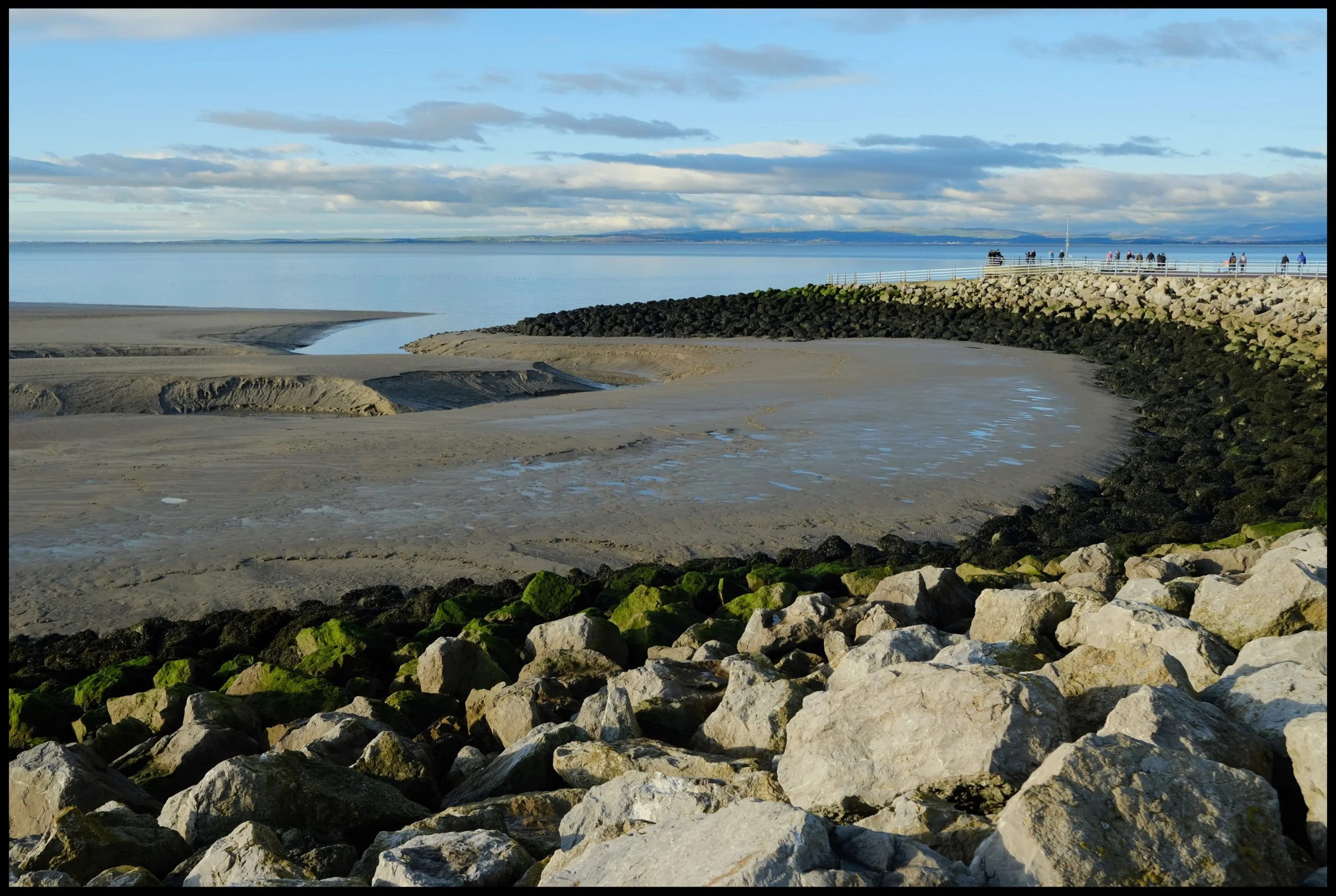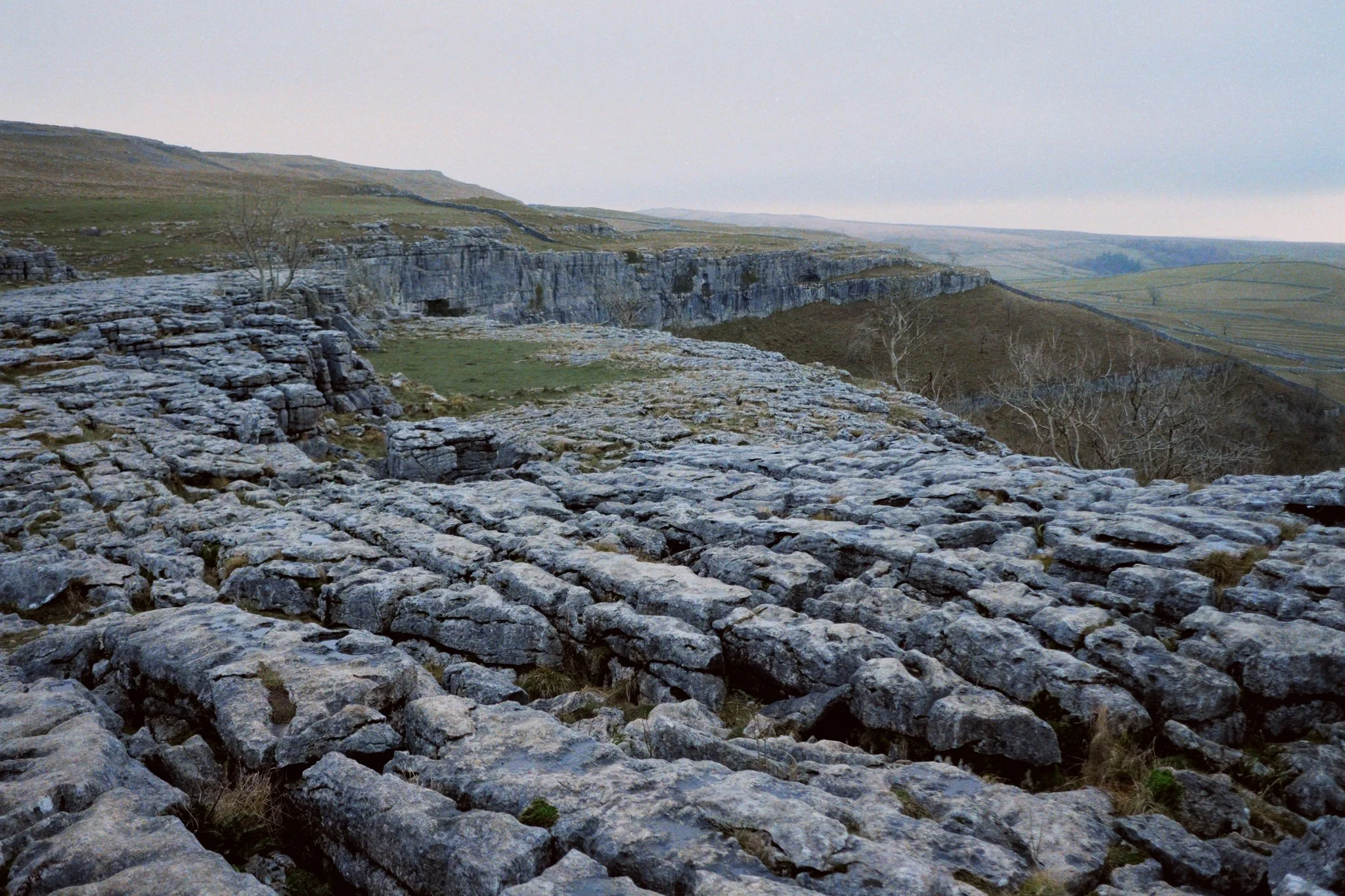Morecambe, Lancashire, Winter
We felt the coast calling us.
We felt the coast calling us.
After an epic hike around Malhamdale in the Yorkshire Dales, followed by a beautiful walk along the Keswick–Threlkeld Railway trail, it was time for something a little more… pedestrian.
The coastline was calling us, and we heeded its call. But where to go? We decided, ultimately, on Morecambe.
Morecambe has a special place in the hearts and minds of the Lisabet family. To start, it’s a favourite destination of her brother, Dwight. Additionally, Lisabet has fond memories of visiting Morecambe with her grandparents for a stroll along the promenade, perhaps with a pit stop for some tea and a slice of cake for good measure.
Morecambe was set up by the Morecambe Harbour and Railway Company to connect the nearby fishing village of Poulton-le-Sands with a railway line. The Company expanded the railway line further. In the 1850s Morecambe was connected to Skipton, Keighley, and Bradford in the West Riding of Yorkshire, and a settlement began to grow around the harbour and railway to service the port and as a seaside resort.
In time, Morecambe became known as the UK seaside resort, which peaked in the middle of the 20th century. In fact, Coco Chanel was known to fly directly to Morecambe from the South of France for weekends at the town, staying at the Midland Hotel.
Like most UK seaside resorts, Morecambe experienced a decline from the 1970s onwards. Even the jewel of the Morecambe promenade, the Midland Hotel, fell into disrepair until its resurrection in 2008.
Plans are afoot, though, to continue the rejuvenation of Morecambe, including the ambitious Eden Project North, no doubt following on from the success of the first Eden Project in Cornwall.
On this day, weather and light conditions were very generous, and Lisabet and I enjoyed several hours along the promenade, soaking in the massive scenes across Morecambe Bay towards the Lakeland fells.
All photos shot on my Fujifilm X-T2 using two of my prime lenses: a Fujinon 23mm f/2.0, and a Laowa 9mm f/2.8. All images made in-camera using Øyvind Nordhagen’s Daylight Fujifilm recipe.
My lovely Lisabet, she who is skilled in the arts of being super cosy.
There appears to be a lot of new signage around Morecambe now. I like the way the design and typography reflects the early 20th century Art Deco style when Morecambe was at its peak.
Aye. Have some respect, people.
On this occasion, the tide was out as evidenced the large and seemingly endless expanse of sand and mudflats (one of the largest in Europe).
Soon we came across this fantastic sculpture, known as the Venus and Cupid (subtitled “Love, The Most Beautiful Of Absolute Disasters”). It was designed by Shane A. Johnstone in 2005.
Views for miles and miles, with some epic clouds to boot.
The people who live in these flats must enjoy some incredible Morecambe Bay sunsets.
A family carefully navigating around Morecambe’s beach pool. No doubt it will be frightfully cold.
Some braver souls than I ventured further out onto the sands. Just be careful of the quicksand…
Lone fishing boats rest lopsidedly in the sands, waiting for the tide to inevitably return.
Plenty of memorials can be found along the promenade in one form or another. Clearly a special place for many people.
Had to use some of these tide breakers as a leading line across the bay towards the Lake District fells.
We soon reach the more “touristy” part of Morecambe’s promenade. Kids playgrounds and B&Bs ahoy.
Near the clock tower one can find this metallic sculpture depicting the Lakeland fells across Morecambe Bay.
You can find some rather colourful and unusually shaped seafront buildings when strolling along the promenade.
Of course, no walk of Morecambe is complete without visiting the Eric Morecambe stature, now seasonally adorned with a Christmas hat and fluffy white beard.
Bringing sunshine to millions of people.
The clouds were looking a little dark, looking back towards Cumbria and North Yorkshire.
I love that some of the buildings in Morecambe still have their original signage.
More new signage that reflects Morecambe’s Art Deco past, complete with palm trees.
It’s rather beautifully done.
Near the Stone Jetty, I wandered around the front of the Midland Hotel to capture some ultra-wide compositions of the buildings curvature.
It’s a cracking building. Glad to see it restored to its former glory.
Around the other side of the hotel, I decided to shoot right into the sun and fully accept whatever weird and wonderful lens flares I got. In the end, not bad at all!
There are bird sculptures aplenty when you follow the Stone Jetty, such as these cool seagulls.
Love the design and layout of the Stone Jetty.
The sun was really starting to break out from the heavy winter clouds, casting long shadows that I couldn’t resist playing with.
One of my favourite bird sculptures found on the Stone Jetty, a rather depressed looking bird.
Near the terminus of the Stone Jetty, Lisabet and I spotted these mudbanks and their curves alongside the boulders. Had to line up a composition.
She’s a beaut.
Lunch was beckoning, but not before I nabbed a few more scenes along the Stone Jetty.
Remember what I said earlier about strange and unusual Morecambe buildings?
This is one of Morecambe’s prettier buildings, though; the Winter Gardens, originally built as the Victoria Pavilion Theatre in 1897.
Pre-sunset, some beautiful golden sunlight was casting beams across various buildings along Morecambe’s seafront. As well as documenting the weird and wonderful, I also wanted to capture the “other” side of Morecambe too.
Some places have existed along the Morecambe seafront for so long they’re practically institutions in their own right, such as the Old Pier Bookshop.
The light just got better and better, and we weren’t the only ones enjoying the scenes.
Another fantastic day.
Malhamdale, Yorkshire Dales, Winter
Merry Christmas everyone!
Merry Christmas everyone!
After a morning of tasty foods and gift exchanging/opening, Lisabet and I decided on a wintery hike around Malhamdale in the Yorkshire Dales.
The Yorkshire Dales has much to offer but a particular jewel in the Park is Malhamdale. The area features the beautiful village of Malham, the epic and ancient extinct waterfall of Malham Cove, the cavernous cathedral of Gordale Scar, and the peaceful waters of Janet’s Foss.
Thinking a Christmas Day hike wouldn’t be too busy, we were surprised by the number of people parked up at the village, ready for their own wanderings around this part of the world.
The day barely topped 4ºC and strong gusty winds often brought temperatures below freezing point. Nevertheless, the scenery was epic, and it certainly whetted our appetite for Christmas dinner later.
All photos taken on my Fujifilm X-T2 using two of my prime lenses: a Fujinon 23mm f/2.0, and a Laowa 9mm f/2.8. Images edited using RNI Films’ Kodachrome profiles, finalised in Affinity Photo.
The Buck Inn, closed for Christmas. It was built in 1874 on the site of an older coaching inn.
It’s not long before we find the path off the road and Malham Cove makes itself very clearly known.
We’re fast approaching Malham Cove and the scale of this sheer limestone wall quickly makes itself apparent.
We hopped around the beck that flows out of the bottom of Malham Cove, seeking compositions.
Ever been underneath an extinct waterfall? Tens of thousands of years ago, a giant waterfall would’ve crashed down here.
After gawping at the sheer verticality of Malham Cove we skirted around its western flank and started the long ascent up the steps towards the top of the Cove.
Around the flanks of Malham Cove, Belted Galloway cows happily grazed on what they could find.
As we near the top of the steps, the views across the Cove to the fells beyond soon open up.
Finally, we make it above Malham Cove. Whilst the main cliff face of the Cove is impressive all by itself, the limestone pavement above—with its clints and grikes—is a different world entirely.
Limestone pavements occur when a glacier retreats and scours limestone, leaving behind a flat bed of rock. Limestone is slightly soluble in water, and rain is slightly acidic, so over time cracks form in the joints of the limestone. Give it a few thousand years or so, and this is the sort of landscape you’re left with.
Up on Malham Cove, the views are extensive, and we can see all the way across Malhamdale, beyond the Aire Gap towards the smooth hills of the Forest of Bowland in Lancashire. Even with the landscape being as epic as it is, the light was also wonderful.
We gingerly hopped our across the clints and grikes of Malham Cove towards its eastern flank, seeking a way towards the footpath that leads to Gordale Scar.
At various points, sudden gaps along the cliff edge opened up, offering views down to Malhamdale. These would’ve been smaller waterfalls that tumbled down Malham Cove, aside from the main one.
At the eastern shoulder of Malham Cove’s curve we could look all the way back to the main cliff face, and see the tiny little people near its edge.
My lovely Lisabet being unusually daring near the edge of Malham Cove’s eastern shoulder. That’s quite a drop, honey…
This shot really shows the sheer drop down from Malham Cove’s sheer southern face. Be careful there, people.
Getting as close to the eastern edge as I dare, really shows the precipitous drop down to the valley floor.
Plenty of people also enjoying the immense views that can be enjoyed from all aspects of Malham Cove.
We found the footpath the leads to Gordale Scar and followed the thankfully easier trail to our next destination. The light was still gorgeous.
The way into Gordale Scar. At this point of the hike, we were joined by a young South Indian student, who wasn’t entirely sure of the way around the trail back to Malham. He was studying at the University of Central Lancashire in Preston. Nice fellow.
A myriad of colours, even in winter.
And there she is, the frankly awe-inspiring sight of Gordale Scar.
The towering crags of limestone, catching the afternoon winter sun above the waterfalls.
Depending on how much water there is in Gordale Beck decides the number of waterfalls that tumble out of the scar.
Mud-slicked limestone made clambering around the boulders in the gorge treacherous, so this was as close as I could get to the waterfalls.
Much of Gordale Scar’s walls actually lean over, dripping water into the gorge.
Such an epic place. I never tire of it.
Our final stop of the day was just down the road from Gordale Scar, a small but beautiful waterfall known as Janet’s Foss. But first, we had to say hi to some Belted Galloways.
The beautiful Janet’s Foss, with its aquamarine plunge pool.
What a wonderful Christmas Day.

